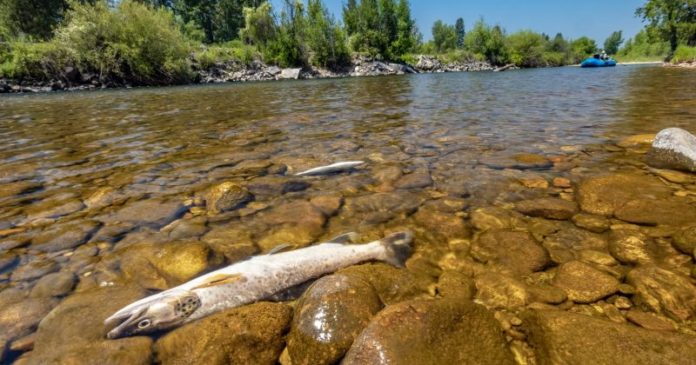Welcome to the latest installment of the Wednesday Wake-Up Call, a roundup of the most pressing conservation issues important to anglers. Working with our friends at Trout Unlimited, Backcountry Hunters & Anglers, the Theodore Roosevelt Conservation Partnership, The Everglades Foundation, Captains for Clean Water, Bullsugar.org, and Conservation Hawks (among others), we’ll make sure you’ve got the information you need to understand the issues and form solid opinions.
If you know of an important issue–whether it’s national or local–that anglers should be paying attention to, comment below, and we’ll check it out!
1. Coalition Calls on Montana Governor Gianforte to Form Cold Water Fisheries Task Force

Two weeks ago, we hosted a Facebook Live event with Guy Alsentzer from Upper Missouri Waterkeeper, Brian Wheeler of the Big Hole River Foundation, and Wade Fellin, of Big Hole Lodge to discuss ongoing problems with trout populations in southwestern Montana. Today, Upper Missouri Waterkeeper submitted a formal letter–signed by a broad coalition of Montana fly fishing outfitters, lodges, and conservation groups, as well as Orvis and Patagonia–requesting that Governor Gianforte immediately create a Cold Water Fisheries Task Force to address the decline of cold water fisheries in the state, particularly in Southwest Montana.
“Maintaining Montana’s cold water fisheries is in everyone’s interest, and the need to protect them for current and future generations is more urgent than ever,” said Simon Perkins, president of Orvis.
The letter follows rapidly deteriorating conditions caused by climate-change related heat and drought that have spiked water temperatures and combined with increased pollution and nutrients from development, leading to early season algal blooms in many rivers and waterways. Trout deaths and die-offs have occurred even before the typically drier, lower water, and warmer summer months of August and early September. An Upper Missouri River Sub-Basin report paints a grim picture for months ahead.
Click here to learn more about the issues.
Click here to read the full letter to Governor Gianforte.
2. Montana FWP Imposes More Fishing Restrictions Due to Drought

As many rivers in southwestern Montana approach historic lows for this time of year, water temperatures have climbed. In response, the state Fish, Wildlife, & Parks Department has responded with measures to protect trout populations from undue stress. The following closures and restrictions went effect yesterday and today:
- A full fishing closure for portions of the Shields River from the confluence with Yellowstone River to USFS Crandal Creek Bridge.
- A full fishing closure for portions of the Big Hole River from the confluence with the Beaverhead River to Tony Schoonen Fishing Access Site.
- A full fishing closure for portions of the Gallatin River from the mouth to Hwy 84 Crossing.
- A full fishing closure for the entire Jefferson River.
- Hoot owl restrictions for the entire reach of the Madison River from the mouth to the boundary with Yellowstone National Park.
- Hoot owl restrictions for portions of the Beaverhead River from the mouth to State Highway 91 South.
- Hoot owl restrictions for portions of the Missouri River from Town of Cascade Boat Ramp to Holter Dam.
- Hoot owl restrictions for portions of the Stillwater River from the confluence with Yellowstone River to Absaroka Fishing Access Site.
- Hoot owl restrictions for portions of the Yellowstone River Hwy 212 Bridge in Laurel to Yellowstone National Park boundary.
Click here for the full story.
3. Army Corps of Engineers Announces Lake Okeechobee Water Plan
Yesterday, the U.S. Army Corps of Engineers announced its recommendation of alternative CC as the preliminary preferred alternative for the Lake Okeechobee System Operating Manual. (Click here for a primer on the Lake Okeechobee System Operating Manual.) The USACE said “Alternative CC” best balances the needs of all stakeholders and communities across South Florida.
This decision was hailed by conservation groups, including Everglades Foundation and Captains for Clean Water, but there is still a lot of work to be done. Dr. Steve Davis, Chief Science Officer of The Everglades Foundation, noted that “although this plan still needs to be optimized to deliver more water south to the Everglades during the dry season, alternative CC is the ideal starting point to a more balanced and fair management of the public’s water.”
Click here for the full story.
Click here to make your voice heard, urging the USACE to optimize Plan CC.
4. Tongass Protections Back in Place, as Roadless Rule Reestablished
Back in June, the Biden administration announced plans to reinstate the Roadless Rule in the nation’s largest National Forest, reversing a decision made in the final months of the previous administration. Last week, the protections created 20 years ago for more than 9.3 million acres of Alaska’s Tongass National Forest were reinstated. Writing in Outdoor Life, Bjorn Dihle writes of this decision:
It shows the USDA is placing its focus squarely where it should be: on the industries (primarily commercial fishing and tourism) that are already thriving in the Tongass, the importance of the Tongass to the people who live here, and on the Tongass’ importance not just to us, but to the rest of America and to the world.
Click here for the full story.
Credit: Source link































